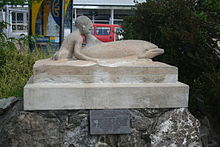- Opo (dolphin)
-
Opo was a bottlenose dolphin who became famous throughout New Zealand during the summer of 1955-56 for playing with the children of the small town of Opononi on the Hokianga harbour.
Opo was a wild dolphin who started following fishing boats around Opononi in early 1955[1] after her mother had been killed, and would swim daily in the bay close to town. She was originally named "Opononi Jack", based on Pelorus Jack, since she was presumed to be male. Unlike the majority of dolphins, she had no qualms about human company, and would perform stunts for locals, play with objects like beach balls and beer bottles, and allow children to swim alongside her and make contact.
Māori children were more reluctant to play with Opo, as cultural beliefs said the dolphin was a messenger from Kupe.
The dolphin became a local celebrity but news of her soon spread, and visitors from throughout the country would come to watch her. On 8 March 1956 official protection for Opo, requested by locals, was made law, but on 9 March she was found dead[2] in a rock crevice at Koutu Point. It is suspected that she was killed accidentally by fishermen fishing with gelignite. Her death was reported nationwide, and she was buried with full Māori honours in a special plot next to the town hall.
Legacy
A song "Opo the friendly dolphin" was recorded by Crombie Murdoch[3] (coincidentally on the same day Opo died) and was highly popular. A second song was written by Julie Collier in 1988.
Several documentary films have been made about Opo. Rudall Hayward made a film called "The Amazing Dolphin of Opononi".
Opo was the inspiration for the Maurice Shadbolt novel This Summer's Dolphin and A children's storybook titled Opo the Gay Dolphin by Avis Acres was published by Reed Publishing Ltd. [4]
A memorial statue of the dolphin playing with a child by Russell Clark was erected in Opononi during the 1950s.[5]
The Museum of New Zealand Te Papa Tongarewa holds a large number of photographs of Opo taken by Eric Lee-Johnson.[6]
See also
References
- ^ "Opo". An Encyclopedia of New Zealand 1966. 1966. http://www.teara.govt.nz/en/1966/opo/1. Retrieved 8 July 2010.
- ^ Hutching, Gerard (updated 6-Nov-09). "Opo at play". Te Ara - the Encyclopedia of New Zealand. http://www.teara.govt.nz/en/dolphins/5/5/1. Retrieved 8 July 2010.
- ^ Hutching, Gerard (updated 6-Nov-09). "Opo at play". Te Ara - the Encyclopedia of New Zealand. http://www.TeAra.govt.nz/en/dolphins/5/4. Retrieved 8 July 2010.
- ^ "Remembering Opo". Te Ara - the Encyclopedia of New Zealand. updated 6-Nov-09. http://www.teara.govt.nz/en/dolphins/5/5/3. Retrieved 8 July 2010.
- ^ "Sculpture of Opo the dolphin". Collections Online. Museum of New Zealand Te Papa Tongarewa. http://collections.tepapa.govt.nz/ObjectDetails.aspx?oid=353692. Retrieved 8 July 2010.
- ^ "Opo". Collections Online. Museum of New Zealand Te Papa Tongarewa. http://collections.tepapa.govt.nz/party.aspx?irn=37094. Retrieved 8 July 2010.
- The songs
- Northern Advocate story on the 50th anniversary of Opo's death.
- Photographs of Opo the Dolphin from the collection of the Museum of New Zealand Te Papa Tongarewa
Categories: 1956 animal deaths | Individual cetaceans | Solitary dolphins | Far North District | History of the Northland Region
Wikimedia Foundation. 2010.

